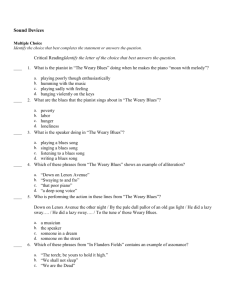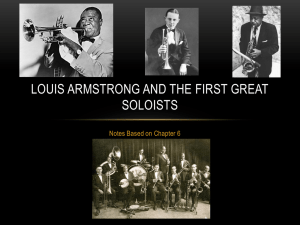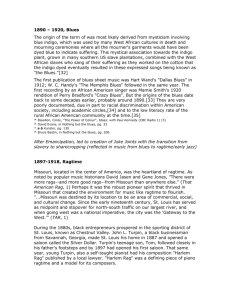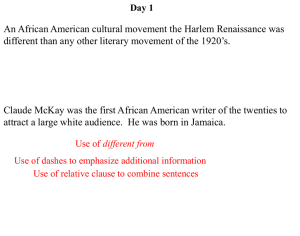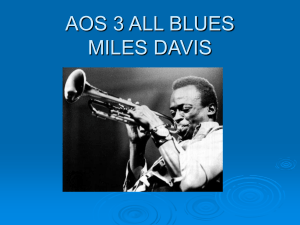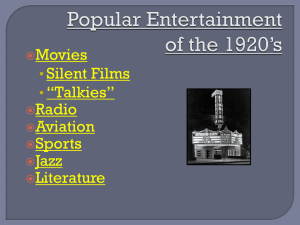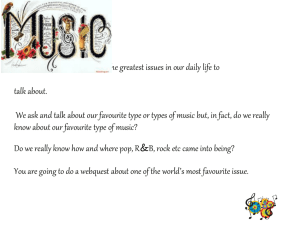Jazz lesson plan
advertisement
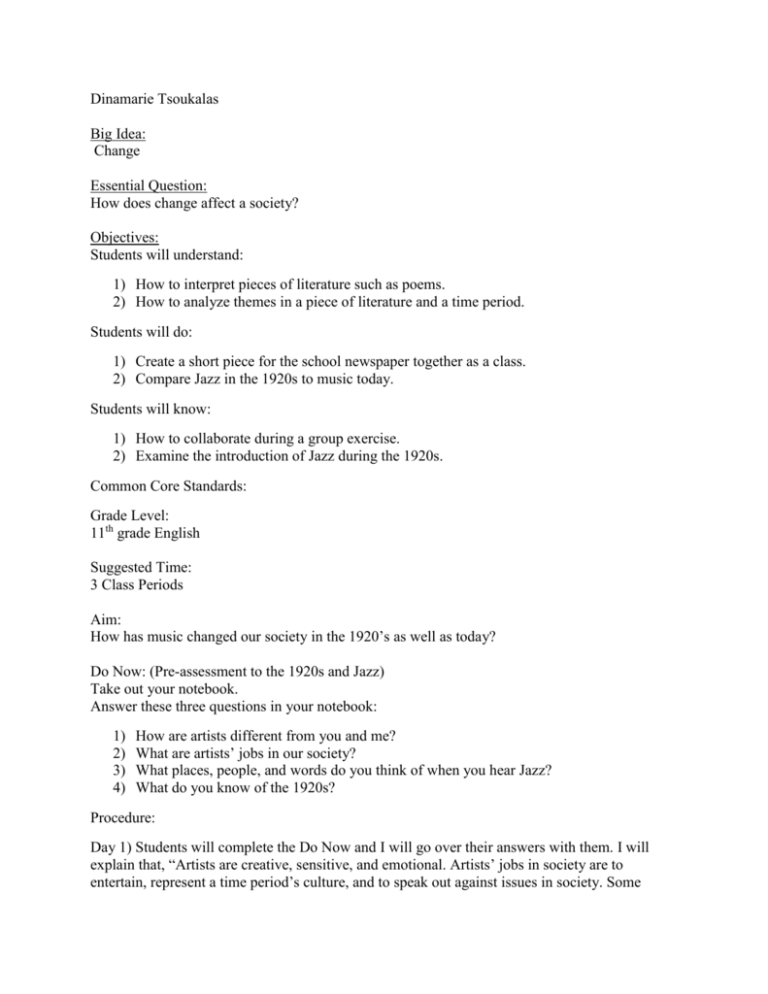
Dinamarie Tsoukalas Big Idea: Change Essential Question: How does change affect a society? Objectives: Students will understand: 1) How to interpret pieces of literature such as poems. 2) How to analyze themes in a piece of literature and a time period. Students will do: 1) Create a short piece for the school newspaper together as a class. 2) Compare Jazz in the 1920s to music today. Students will know: 1) How to collaborate during a group exercise. 2) Examine the introduction of Jazz during the 1920s. Common Core Standards: Grade Level: 11th grade English Suggested Time: 3 Class Periods Aim: How has music changed our society in the 1920’s as well as today? Do Now: (Pre-assessment to the 1920s and Jazz) Take out your notebook. Answer these three questions in your notebook: 1) 2) 3) 4) How are artists different from you and me? What are artists’ jobs in our society? What places, people, and words do you think of when you hear Jazz? What do you know of the 1920s? Procedure: Day 1) Students will complete the Do Now and I will go over their answers with them. I will explain that, “Artists are creative, sensitive, and emotional. Artists’ jobs in society are to entertain, represent a time period’s culture, and to speak out against issues in society. Some things associated with Jazz are Louis Armstrong, Bessie Smith, Chicago, Harlem, and New Orleans, loud, fast paced, impact morals, and dance with flappers”. Then I will hand out a poem by Langston Hughes that depicts the era of Jazz in the 1920s. The Weary Blues Langston Hughes (1923) 1 2 3 4 5 6 7 8 9 10 11 12 13 14 15 16 17 18 19 20 21 22 23 24 25 26 27 28 29 30 31 32 33 34 35 Droning a drowsy syncopated tune, Rocking back and forth to a mellow croon, I heard a Negro play. Down on Lenox Avenue the other night By the pale dull pallor of an old gas light He did a lazy sway .... He did a lazy sway .... To the tune o' those Weary Blues. With his ebony hands on each ivory key He made that poor piano moan with melody. O Blues! Swaying to and fro on his rickety stool He played that sad raggy tune like a musical fool. Sweet Blues! Coming from a black man's soul. O Blues! In a deep song voice with a melancholy tone I heard that Negro sing, that old piano moan-"Ain't got nobody in all this world, Ain't got nobody but ma self. I's gwine to quit ma frownin' And put ma troubles on the shelf." Thump, thump, thump, went his foot on the floor. He played a few chords then he sang some more-"I got the Weary Blues And I can't be satisfied. Got the Weary Blues And can't be satisfied-I ain't happy no mo' And I wish that I had died." And far into the night he crooned that tune. The stars went out and so did the moon. The singer stopped playing and went to bed While the Weary Blues echoed through his head. He slept like a rock or a man that's dead. We will read the poem together and interpret it. I’ll ask the students which words they see that reminds them of Jazz and the blues. Also, I will ask, “What change in society is the speaker presenting?” I will ask them, “Who listens to and why do people listen to Jazz?” Louis Armstrong, Formative Assessment: I will ask them for homework to listen to their favorite rock, hip hop, or blues songs. Day 2 The class would be split into groups with 4 students in each. I will pick out the groups and differentiate the students. I will hand all of the students lyrics to Bessie Smith and Louis Armstrong’s song, “St Louis Blues” and let them watch a video to see how the 1920’s music was portrayed. Then I will play the song, “(edited) so they can hear the lyrics and see the music of today. I will not pay the song in its’ entirety, but enough so they get the idea. http://www.youtube.com/watch?v=CqujvTl5zns&feature=related http://www.youtube.com/watch?v=o1T8nG-2VNg I will ask them to answer by filling out the chart, “Some music critics have argued that one can hear jazz in more contemporary (and popular) styles of music, such as rock, blues, and hip-hop. Then after about 15 minutes I will get the class back together and fill out the chart together on the smart board. Bessie Smith and Louis Armstrong “St Louis Blues” Deja Vu lyrics Songwriters: Jr. Webb;Rodney Jerkins;Kelly Price;Shawn Carter;Makeba Riddick;Delisha Thomas;Beyonce Giselle Knowles;Kellie Nicole Price Baby, seem like everywhere I go I see you From your eyes I smile, it's like I breathe you Helplessly I reminisce, don't want to Compare nobody to you Boy, I try to catch myself but I'm outta control Your sexiness is so appealing, I can't let it go, baby Know that I can't get over you, 'cause everything I see is you And I don't want no substitute, baby, I swear it's deja vu Know that I can't get over you, 'cause everything I see is you And I don't want no substitute, baby, I swear it's deja vu Baby, I can't go anywhere without thinking that you're there Seems like you're everywhere, it's true, gotta be having deja vu [From: http://www.elyrics.net/read/b/beyonce-lyrics/deja-vu-lyrics.html] 'Cause in my mind I want you here, get on the next plane, I don't care I'm missing you, that I'm having deja vu Boy, I try to catch myself but I'm outta control Your sexiness is so appealing, I can't let it go Know that I can't get over you, 'cause everything I see is you And I don't want no substitute, baby, I swear it's deja vu Know that I can't get over you, 'cause everything I see is you And I don't want no substitute, baby, I swear it's deja vu Know that I can't get over you, 'cause everything I see is you And I don't want no substitute, baby, I swear it's deja vu Know that I can't get over you, 'cause everything I see is you And I don't want no substitute, baby, I swear it's deja vu Questions: Who is the song’s audience? Example: Race Gender Social Status Location Is there a strong point/message? If so, what is it? Example: Theme Message Moral What kind of sounds/ words do you hear? Example: Instruments Pace Rhythm Repetition Bessie Smith and Louis Armstrong “St. Louis Blues” Groups song: Formative Assessment: I will have the students go onto our class wikipage and I will ask them to write how Jazz from the 1920s changed music today and how jazz impacted artists’ music today. Day 3: In class we will go back to our wikipage and collaborate as a class all the ideas we put on our page into a short introduction to Jazz music of the 1920’s and today and send it to the school newspaper to be published. Music of the 1920’s Write a letter to a musician from the 1920’s (ex. Louis Armstrong or Bessie Smith). In the letter explain how you either like Jazz music or you do not like Jazz music. You must give specific reasons why from watching and listening and watching St. Louis Blues (ex. rhythm, pace, lyrics) Choose one of the three towns we talked about in class where Jazz originated. Research more about them and find pictures and phrases that represent that specific area (the internet, magazines, newspaper etc.) Put these pictures into a collage. Write up a 2 paragraph summary of why you chose those specific pictures or phrases. Using Prezi, create a presentation on answering the question using Jazz during the 1920’s as an example, How do artists use music to depict the society during that time period? (Ex. Morals, geographically, economically, emotionally, culturally etc.)
